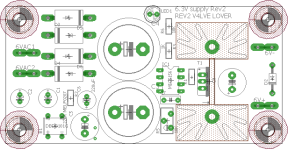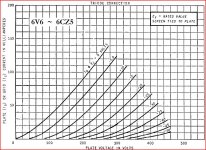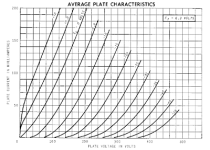Do some real troubleshooting first, then replace parts.
Is there a:
Signal Input connector and input tube cathode circuit Ground Loop?
Power Supply Ground Loop?
Signal Source cable to Preamp input Ground Loop?
Preamp output cable to Power Amplifier input Ground Loop?
Mains Power ground loop: Signal source to preamp?
Mains Power ground loop: Preamp to power amplifier?
Bad solder connection when a part was replaced.
Ground connection that has a bad solder connection, or wire came off, or a metallic connection to ground has been disturbed (like a solder lug to chassis connection).
Depending on the schematic, there are some places that you can ground, or at least shunt signal and hum to ground using a capacitor.
Careful, do the connection with the preamp unpowered. Make sure that the grounding wire or shunt capacitor to ground will not disturb the circuitry.
Regarding the power supply's first filter capacitor, the higher the capacitance, the larger the transient inrush current is with each alternation of 50Hz/60Hz (100/120). The ground loop needs to be kept short and local, or it will get into the rest of the amplifiers circuitry.
Is there a:
Signal Input connector and input tube cathode circuit Ground Loop?
Power Supply Ground Loop?
Signal Source cable to Preamp input Ground Loop?
Preamp output cable to Power Amplifier input Ground Loop?
Mains Power ground loop: Signal source to preamp?
Mains Power ground loop: Preamp to power amplifier?
Bad solder connection when a part was replaced.
Ground connection that has a bad solder connection, or wire came off, or a metallic connection to ground has been disturbed (like a solder lug to chassis connection).
Depending on the schematic, there are some places that you can ground, or at least shunt signal and hum to ground using a capacitor.
Careful, do the connection with the preamp unpowered. Make sure that the grounding wire or shunt capacitor to ground will not disturb the circuitry.
Regarding the power supply's first filter capacitor, the higher the capacitance, the larger the transient inrush current is with each alternation of 50Hz/60Hz (100/120). The ground loop needs to be kept short and local, or it will get into the rest of the amplifiers circuitry.
Last edited:
Great project Salas.
@Lingwendil looking forward to hearing more about the boards, I would love to try an octal!
Nice weekend to all : )
@Lingwendil looking forward to hearing more about the boards, I would love to try an octal!
Nice weekend to all : )
Anybody ran the 6V6 in pentode mode yet? Have tried a few by now and am quite liking them. Soon up is a pentode vertical deflection amp type.
Douglas
Douglas
Here are the Gerbers for a little 50x100mm 40mm high LDO supply i made to turn 6.3VAC into 6.3VDC stabilized DC. Regulator dropout is lower than 120mV at 2.5A
Great if you have hum issues, and cant upgrade the existing supply for something like LM317.
I also make these to order.
Great if you have hum issues, and cant upgrade the existing supply for something like LM317.
I also make these to order.
Attachments
Just got in my small PCBs for the power supply that is meant to go with these, and redid my workshop enough to try and actually work in it. Hopefully some more progress soon. Similar to this posted implementation- https://www.diyaudio.com/community/threads/6v6-line-preamp.102352/page-243#post-7319674Great project Salas.
@Lingwendil looking forward to hearing more about the boards, I would love to try an octal!
Nice weekend to all : )
Apologies on how slow going things are, lots of busy work at my day job, and busy at home in my off time.
Just a question out of interest. Has anyone tried a 6AH4 in place of the 6V6 in triode?
Performance looks to be fairly similar. 6AH4 is a nice tube.
Performance looks to be fairly similar. 6AH4 is a nice tube.
Second Andy; those are quite good...and IIRC you can also use 6CK4 in the same socket...
Douglas
Douglas
6CK4 and 6AH4 grid is connected to pin 1.
Caution: The 6CK4 also has its grid connected to pin 3, as well as pin 1. If your 6AH4 amplifier ties any circuit to the socket pin 3 (to use it as a "free tie point"), and you plug in a 6CK4, you are asking for trouble.
The 6CK4 and 6AH4 have different specifications.
Gm, transconductance 5500uM, 4500uM
u, Mu, 6.6, 8.0
plate resistance, rp 1200, 1780
plate dissipation, Watts 12, 7.5 Watts
filament current,1.25A, 0.75A
Depending on the amplifier circuit, parts, B+ capability, filament winding capability, etc., then . . .
It is either Plug and Play
OR
it is Plug and PRAY.
The tubes are not the same.
Want some tubes that are essentially the same?
6BQ5, EL84
EL34, KT77
12AU7, ECC82
and many many others
Caution: The 6CK4 also has its grid connected to pin 3, as well as pin 1. If your 6AH4 amplifier ties any circuit to the socket pin 3 (to use it as a "free tie point"), and you plug in a 6CK4, you are asking for trouble.
The 6CK4 and 6AH4 have different specifications.
Gm, transconductance 5500uM, 4500uM
u, Mu, 6.6, 8.0
plate resistance, rp 1200, 1780
plate dissipation, Watts 12, 7.5 Watts
filament current,1.25A, 0.75A
Depending on the amplifier circuit, parts, B+ capability, filament winding capability, etc., then . . .
It is either Plug and Play
OR
it is Plug and PRAY.
The tubes are not the same.
Want some tubes that are essentially the same?
6BQ5, EL84
EL34, KT77
12AU7, ECC82
and many many others
Last edited:
andyjevans,
Many circuits will work without modifications, but many other circuits will not work without modifications.
I added the 6CK4 and 6AH4 tube specs to my Post # 4,872.
Yes, I still do want to try using a 6AH4-GT (probably in a balanced amplifier)
Note the -GT, there does not to be a 6AH4 that is not a -GT (just for those who can not find the tube).
Andy, Thanks for mentioning it!
Intriguing!
Many circuits will work without modifications, but many other circuits will not work without modifications.
I added the 6CK4 and 6AH4 tube specs to my Post # 4,872.
Yes, I still do want to try using a 6AH4-GT (probably in a balanced amplifier)
Note the -GT, there does not to be a 6AH4 that is not a -GT (just for those who can not find the tube).
Andy, Thanks for mentioning it!
Intriguing!
For what I consider a generic linestage circuit, 6CK4 is a direct plug in for a 6AH4. Current reg plate load and LED bias. As mentioned, be aware of the connections so this does not cause an issue. Rather like rigging a power stage to run either a 26LW6 or a 26HU5. Pins not the same, but with planning, they will serve in place of one another... 🙂
Douglas
Douglas
I agreed. I prefer the sound of 6AH4 over 6CK4 even if the latter is more powerful.I was referring to the 6AH4 which I prefer to the 6CK4. I tried both.
Hi Salas, What would be the effect of using a 10k resistor in lieu of the 7.5k you chose for the CC 10dB gain / 6dB NFB version?
Hi, bias point will shift. Ip 4mA down Vp 22V down, gain will remain the same, THD 2dB less. In other words it doesn't change spec significantly for in ballpark plate load resistor other than less available output current and max negative going swing. Due to governed by the parallel feedback (Schade) network.
Speaking of 6AH4, 6CK4, 6V6, etc...
Has anyone tried 6W6GT in triode for a line level preamp?
Too much of a knee down near cutoff for small signal use?

Has anyone tried 6W6GT in triode for a line level preamp?
Too much of a knee down near cutoff for small signal use?
computed versus actual values do not always jibe, say you wanted 5mA plate current, be prepared to see more or less than that in the actual, this is not surprising at all.....
- Home
- Amplifiers
- Tubes / Valves
- 6V6 line preamp






